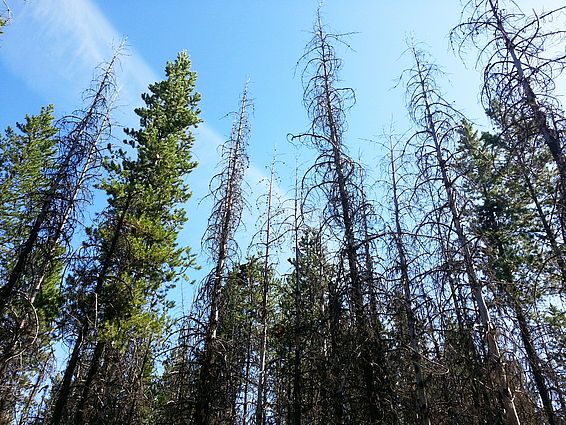10.12.2018 | News WSL
They do not mind the cold, but severe dry spells really put a strain on them: Lodgepole pines in the high north of Canada cannot adapt well to drought. This was the result of the study of a unique field trial in which the Swiss Federal Institute for Forest, Snow and Landscape Research (WSL) was involved. The findings could potentially also apply to Swiss mountain forests.
There are many indications that drought will become more frequent and last longer with climate change. Trees must be able to endure this, otherwise they die. But why are some trees better at dealing with drought than others? Trees adapted to the cold, such as the lodgepole pine (Pinus contorta) in the forests of northern Canada, seem to have little tolerance to drought. A research team from Canada, Germany and Switzerland used tree rings to investigate the biological background.
The team around Miriam Isaac-Renton from the University of Alberta (Canada), was able to use a unique long-term experiment for this purpose. More than 30 years ago, pine seedlings from northern, moist and cold regions were transplanted to a warmer location, which simulates a warming scenario. The team obtained data on numerous biological processes of tree growth from the tree rings of the adult pines, from which the adaptability of the trees to dry periods can be deduced. These adaptive traits include stem growth, the structure of the water-transporting wood tissue and fluctuations in the opening width of the stomata, the pores in the leaves that trees can close during dry periods in order to prevent imminent water loss.
Damage caused by water scarcity
The researchers found that the trees from the northern limit of the species’ distribution produce wood cells with very thin cell walls in a drought year, when grown in southern locations simulating climate warming. This makes them susceptible to damage to the water transport system when water is scarce. Furthermore, during drought, these trees do not seem to be able to regulate their stomata very well. «Our results show that trees from these northern, cold regions are physiologically poorly adapted to severe drought », explains co-study leader Kerstin Treydte from WSL. The researchers have now published the results in the scientific journal Nature Communications.
Mountain forests may also be endangered
The result is interesting for Switzerland because it shows that trees at a cold-related distribution limit, such as the high altitudes of the Alps, may not necessarily benefit from future global warming if conditions become drier at the same time. Higher temperatures may temporarily improve growth conditions in cold regions, as has been demonstrated in many places in the Alps. However, increased dry spells could negate this benefit in the long run. «Climate change and extreme weather conditions associated with it, such as drought, affect forests worldwide. Tree species from dry regions of origin are better adapted to such extremes than tree species now living in comparatively humid areas. If drought events increase in the future, the latter will be at greater risk», explains Treydte. This applies to the boreal lodgepole pine, but possibly also to tree species at high elevations in the Alps.
However, the study also points to a possible solution, at least for forestry: It could be demonstrated that trees from more southern regions of Canada can physiologically cope better with drought. Therefore, foresters may be able to increase the drought tolerance of forests by planting seedlings of southern origin in the regions that are at-risk and thus anticipate extreme climate events.
[Translate to Englisch:] Kontakt
(Kopie 4)
Copyright
WSL and SLF provide the artwork for imaging of press articles relating to this media release for free. Transferring and saving the images in image databases and saving of images by third parties is not allowed.
Links and documents
Original publication:
Isaac-Renton M, Montwé D, Hamann A, Spiecker H, Cherubini P, Treydte K: North American pine populations are limited in their physiological adaptation to drought. Nature Communications. DOI: 10.1038/s41467-018-07701-0


